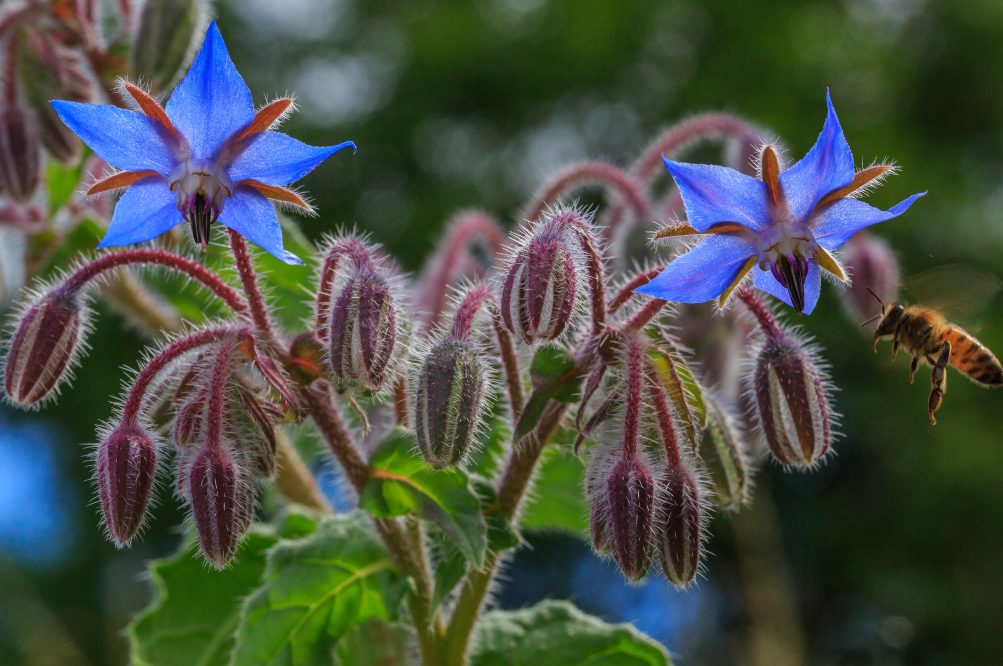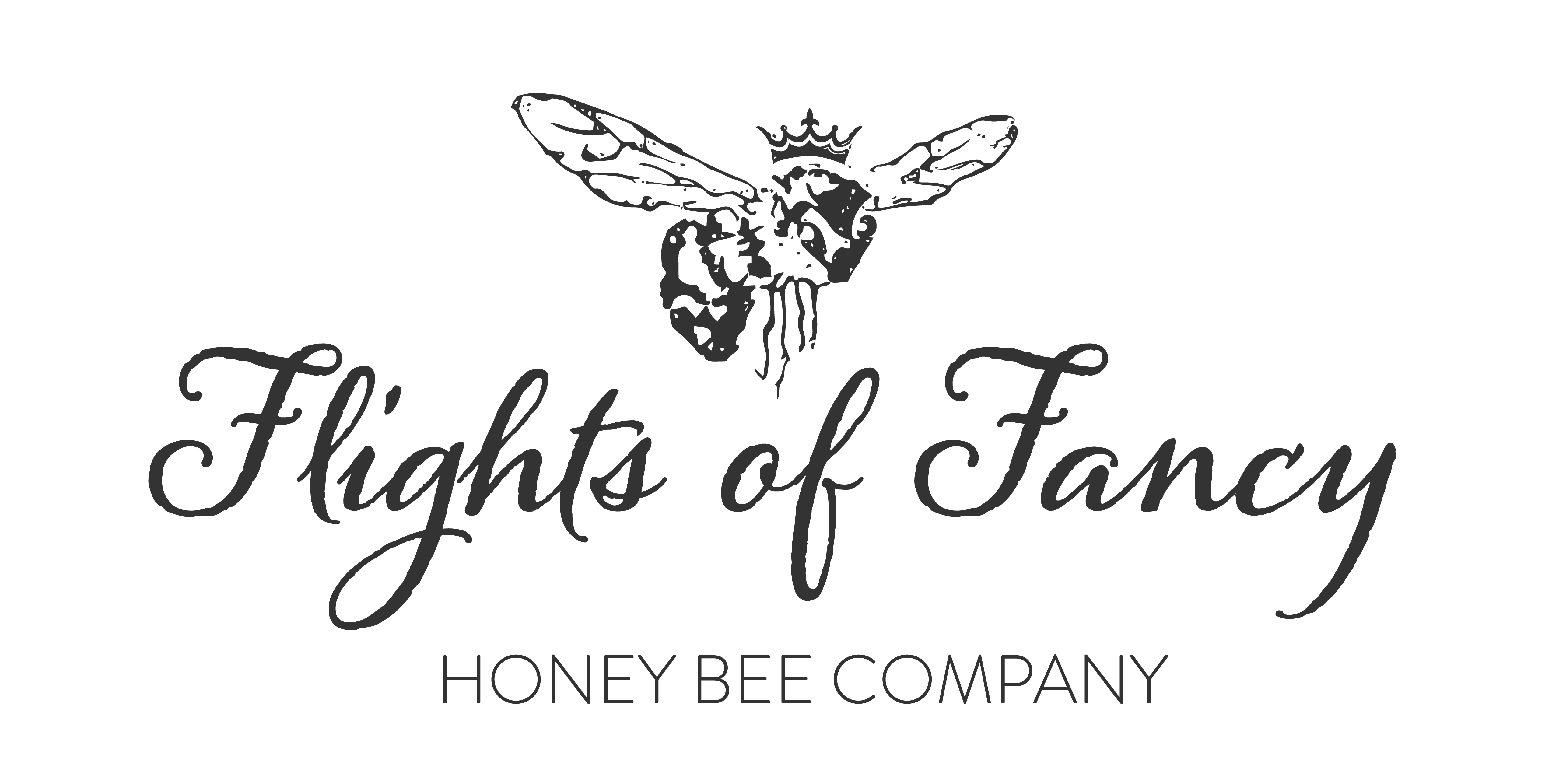Borage: Pollinator Plant Extraordinaire

The Honey Plant

Borage is a pretty important plant to both honey bees and bumblebees alike. The attractive star-shaped flowers of borage add texture and unique interest in the garden as they turn from blue to pink. The fuzzy leaves and purple portions near the blooms make it a wonderful companion plant that also makes excellent green manure. Additionally, borage leaves and flowers make a calming tea and the pretty blossoms are actually edible, even able to be frozen in ice cubes for cocktails. But its prolific nectar and pollen production is what makes borage an invaluable plant in the pollinator garden.
As a food source for bumblebees and honey bees, borage refills with nectar every two-five minutes throughout the day, unlike most plants, and it continues to yield nectar even in cold weather making it a significant bumblebee plant. Most pollinators will ignore the plant’s downward-facing blooms but there is a reason for these flowers with a challenging angle, it prevents rainwater and morning dew from diluting the plant’s nectar for the bees!
For longer bloom periods, stagger the seeding dates. Borage will adapt to many soil types, but grows largest and flowers most prolifically in rich, fertile soils.
Borage, a classic edible and medicinal old world bee plant, borage is easy to sow and fast to grow. Honeybees and bumblebees sip its nectar and collect ivory pollen in their corbiculae. Once established, the plants will self-seed and pop up throughout the season in the garden, providing a continuous supply of nectar and pollen summer through fall. The blossoms pimp out the nectar all day long and the heads hang down in the rain to protect the nectar from being diluted. Bumblebees buzz-pollinate the blooms and cover themselves in showers of blue-grey or off-white pollen. The flowers are edible, with a slight hint of cucumber flavour. – Victory Gardens for Bees
Host Plants For Butterfly Caterpillars

Borage plays an important role as a host plant for the painted lady butterfly (pictured left), and it also serves as a valuable plant for native bees and honey bees. Adult butterflies and most other pollinators except for Bumblebees, Honey Bees, and Leafcutter Bees, will ignore the downward-facing blooms of the borage plant until it comes time to lay their eggs, that’s when the borage plant steps into its’ other role, as a host plant for caterpillars that will one day transform themselves into butterflies.
Borage Nectar & Pollen Production
Honey bee hives placed on acres of borage can produce up to 200 lbs of honey per acre planted and between 60-160 lbs of blue-grey pollen per acre planted.
Borage As A Cover Crop & Green Manure
Borage is quick-growing and quick to establish itself, it also has a large taproot that allows the plant to pull nutrients that are deep down in the soil, back up to the top, while aerating the deeper layers of earth within your garden. As the plant decomposes, the nutrients it drew up through its large taproot are replenished back into the soil but at the top layers this time. Borage is also a nitrogen fixer both while it is growing and as it is decomposing. It also provides potassium and calcium back into the soil. Also, borage leaves, like comfrey and yarrow, act as a compost activator.
Collecting Seeds
Borage is a fast-growing annual that can re-seed itself within the same season and certainly can re-seed itself for the following season. If you would prefer to not have it re-seed itself, once the flowers turn pink and drop to the ground you can snip the portion of the plant where the bloom fell from before the seed starts to form. If you would like to collect the seeds, wait until the blooms have dropped from the plant and it has started to dry out and turn brown.
Place some landscape cloth down around the base of the plant. Next run your hands through the dried ends of the plant, rubbing the plant between your hands. The seeds, which are dark-colored and round, will fall onto the landscape material. After finishing with the plant, you can carefully fold the edges of the cloth together to secure the contents in the center. Take the cloth somewhere that has enough light and a stable surface to sort through the dried plant pieces and the seeds.
Where To Get Borage Seeds
Let’s Feed Some Bees Program: Every Flights of Fancy order between March 20th – May 30th receives a free packet of pollinator seeds. There are five options to choose from, one of the seed options is Sunflowers (while supplies last), learn more here.
Looking to just purchase seeds? Check out West Coast Seeds.
How To Grow Borage
Instructions
- Season: Cool season Exposure: Full sun to partial shade
- Direct sow in mid-to-late spring. Borage develops a delicate taproot, so it’s best direct sow where it is to grow. Borage does not transplant well. Optimal soil temperature for germination: 21°C (70°F). Seeds should sprout in 5-15 days.
- Sow seeds 1cm (½”) deep, and thi n to 60cm (24″) apart. Borage will get large and fill in spaces between plants.
- Borage is an un-fussy, self-sowing annual. To avoid self-sowing, the flower heads need to be picked regularly. Borage does best in full sun in well drained soil.
Notes
About The Author
Related Posts
7 Heavenly Honey and Tea Combinations to Try on National Tea Day
Looking for a way to celebrate National Tea Day? Check out our blog post featuring…
April 8, 2023The Power of White Clover: How This Humble Plant Can Benefit Pollinators and Your Soil
The Power of White Clover: How This Humble Plant Can Benefit Pollinators and Your Soil…
March 27, 2023




